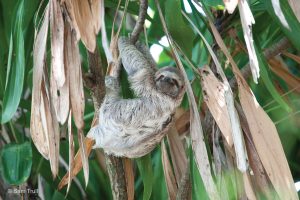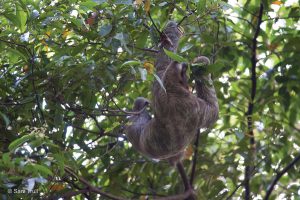Releasing Orphaned Sloths Back into the Rainforest

By Sam Trull
Sometimes people ask us why and how we release orphaned sloths and why are they orphaned in the first place. We believe sloths deserve a second chance to be wild and that preventing harm to wild sloths from human encroachment is a priority. Here is our philosophy on this very important subject.
Why release? How do we know that they are ‘fit’ to live in the wild again? How do we know they deserve to live in the wild and weren’t rejected from their mothers for a reason? Are we playing god?
We aren’t playing god and we aren’t changing the natural evolutionary process that sloths have mastered over millions of years. Sloths require rescuing, in the first place, because of human encroachment on their natural habitat. Our goal is to right the wrongs that have been placed upon these wild populations. In Manuel Antonio we have witnessed, on many occasions, human disturbances causing separation from mom. Loud noises from a chain saw that cause mom to retreat to a part of the tree that baby can’t follow; tree trimming while a mom and baby duo were in the tree that caused baby to fall; dog attacking mother but baby surviving. These are just a few of the obvious reasons babies can be separated from their mothers. But there are also less obvious factors from the change in the availability of natural resource, all caused from human encroachment to their environment. It may sometimes be natural for mothers to abandon babies but those unfortunate creatures who are born with lethal defects are more likely to not survive being rescued nor are they likely to survive the rehab process. The rehab process is not easy and it’s not a guarantee of survival. Sloths still need to be relatively ‘fit’ in order to successfully conquer the hardships of captivity.

There is no evidence that sloths are healthier in cages. In fact, there is quite a lot of evidence that sloths are less healthy in captivity. They don’t survive the stress from being confined or being fed inadequate captive diets. They aren’t better off living their lives in cages, they aren’t actually any safer that way. They certainly aren’t happier that way.
How do we teach orphaned sloths to ‘be wild’?

Successfully learned behaviors are often the result of trial and error episodes. Wild moms don’t literally teach everything…they are often times just babysit while their infants explore life for themselves. Our rehabilitation and soft release process mimics that of a mother’s ‘watchful eye’. We allow the young orphaned sloths to explore a wild environment and encourage them to eat the same foods their wild conspecifics are eating, all while being that safety net that they require. Sloths, like humans, are happiest in an environment where they are continually pushed to learn and have the ability to express their wide range of innate desires. Seeing them happy is what motivates me and my team every day to constantly live outside of our own comfort zone while tracking wild and hand-raised orphaned sloths in the jungles of Costa Rica. It is our goal that one day we have a complete behavioral picture of what it means to be a sloth so that we can help every animal that comes into our care reach their full potential and continue to be a part of this circle we call life.
About The Sloth Institute: The mission of The Sloth Institute Costa Rica is to enhance the well-being and conservation of wild and captive sloths through research and education. TSI is also dedicated to collaborating with sloth rehabilitation programs KSTR in Manuel Antonio and Toucan Rescue Ranch in San Jose, Costa Rica to release their hand-raised orphaned sloths. For more information, visit www.theslothinstitutecostarica.org.
